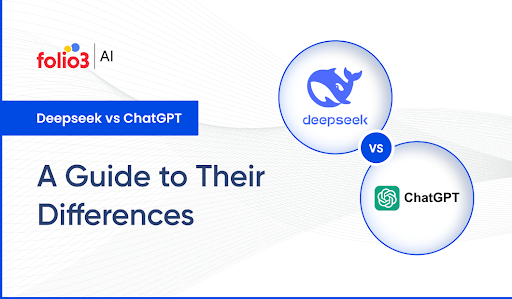DeepSeek, China’s new AI chatbot, has disrupted the large language model market. Thousands of people are using it and finding its queries incisive, leaving ChatGPT behind. Its ultra-efficient model and no messaging limits have driven users into a frenzy. It feels like a “wake-up” call for OpenAI to raise its standards.
The DeepSeek R1 model claims to match OpenAI advanced GPT-o1, especially in following a “chain of thought.” Even though users are impressed with its speed, it’s a fact that ChatGPT still competes with its broader features and creative capabilities, making it a reliable tool for specific “businesses” to perform various essential tasks.
Users who have experimented with both platforms state that DeepSeek vs ChatGPT provides nearly identical responses, differing slightly in presentation and sourcing. However, DeepSeek’s unlimited messaging offers uninterrupted conversations, unlike ChatGPT, which imposes limits that often push users to upgrade.
Let’s have a DeepSeek vs Chatgpt comparison and look for ourselves. What’s the fuss, and discern between them? For that, continue reading.
What is DeepSeek?
The hype around DeepSeek is already growing. To help new users understand, it’s an AI chatbot from China powered by the R1 model. It is a conversational AI platform emerging from Hangzhou. It was founded in July 2023 by Lian Wenfeng, who has a background in quantitative finance. DeepSeek aims to rival established AI models like ChatGPT and other industry giants. Its sharp query responses, ultra-efficient performance, and lack of messaging limits make it a strong alternative in the AI market.
Key Features of DeepSeek AI
- Advanced Chain-of-Thought Reasoning – works best in logical reasoning and step-by-step problem-solving, making it highly effective for complex queries.
- Open-Source Customization – It’s not like proprietary models. DeepSeek allows users to modify and improve the model according to their needs.
- Unlimited Messaging – No chat restrictions, enabling continuous and uninterrupted conversations. It acts like talking, unlike ChatGPT’s usage limits.
- High Processing Efficiency – Optimized for fast response times. To keep the rhythm going, ensure users get accurate answers with minimal delay.
- Strong Multilingual Support – Can handle multiple languages efficiently, making it useful for diverse global users.
- Comparable to GPT Models – Performs at a level similar to OpenAI’s advanced GPT-o1 model in user tests.
- Versatile Use Cases – Suitable for various applications, including customer support, content generation, technical problem-solving, and language translation, making it an adaptable platform.
What is ChatGPT
We’re all familiar with this platform, right? Businesses worldwide rely on it for repetitive tasks and sometimes even critical decision-making. It’s also a go-to for users seeking answers to their unresolved queries. It was launched in November 2022 and built to create text that looks like human language based on user input. Not only that, ChatGPT has a strong prowess in understanding context, answering questions, creating content, and even holding conversations on any topic given. The best part of this model is its versatility, which helps individuals, businesses, and developers with various tasks, from content generation to customer support.
Key Features of ChatGPT
- Human-Like Conversations – Generates coherent, context-aware dialogues that mimic human interaction, making it suitable for customer support and social engagements.
- Extensive Knowledge Base – Trained on diverse internet data, ChatGPT offers accurate information on various subjects, from science to pop culture.
- Text Generation – Excellent at producing written content for blogs, articles, stories, and more, with customizable tones and styles.
- Multitasking Ability – Handles multiple tasks at once, offering solutions in various domains like programming, writing, problem-solving, and research.
- Fine-Tuning & Customization – Developers can fine-tune ChatGPT’s behavior and responses, mainly through integration with other tools like the OpenAI API.
- Language Support – While primarily English-based, ChatGPT can understand and generate text in multiple languages, making it useful for global audiences.
- Integration with Apps – Easily integrated with other applications and services, enhancing workflows and productivity.
- Creativity and Innovation – Known for generating creative ideas, brainstorming, and assisting with innovative projects across various industries.
Deepseek vs Chatgpt- Technologies and Training Models
Now that you know these platforms, let’s look at the models and technologies used in DeepSeek and ChatGPT. It’ll help you get a better grip on how they stack up – and maybe settle the comparison debate.
DeepSeek
- DeepSeek-R1: A high-performance model known for its advanced chain-of-thought reasoning and efficient processing.
- DeepSeek V3: An upgraded version offering augmented speed and accuracy for complex tasks.
- DeepSeek V2.5: A versatile model focused on fast and efficient task execution with open-source customization.
ChatGPT
- GPT-4: An innovative language model with deep reasoning and context-understanding capabilities.
- GPT-4 Turbo: A faster, more cost-efficient version of GPT-4, optimized for real-time performance.
- GPT-4o: Specially tuned for advanced reasoning tasks and complex problem-solving.
- GPT-4o mini: A compact variant of GPT-4o, offering quick responses for specific tasks.
- O1: A general-purpose model with high accuracy for broad AI applications.
- O1-mini: A lightweight model designed for fast responses with reduced resource requirements.
- O3: Known for handling large-scale tasks and delivering superior performance in dynamic environments.
- O3-mini: A smaller, optimized version of O3, focusing on agility and speed in processing.
Core Differences Between Deepseek and ChatGPT
When comparing DeepSeek vs ChatGPT, the notable differences lie in messaging limits, customization, reasoning, and creativity. Both Deepseek and ChatGPT serve different purposes in AI. Deepseek is primarily designed for advanced data retrieval and analysis, focusing on extracting and synthesizing information from large datasets. In contrast, ChatGPT, developed by OpenAI, is geared toward conversational interaction, enabling users to engage in natural language dialogues.
While ChatGPT excels in understanding context, generating human-like responses, and maintaining conversational flow, Deepseek emphasizes precision and depth in data-oriented tasks. Let’s experiment with DeepSeek and ChatGPT to see how they respond when prompted.
Question 1- “What’s the latest news and recently released AI technologies making headlines?”
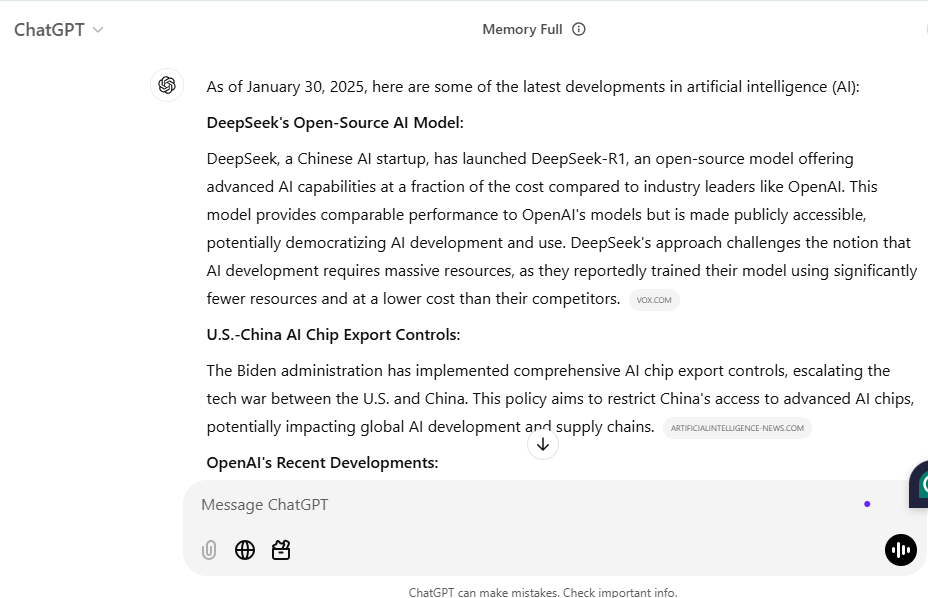
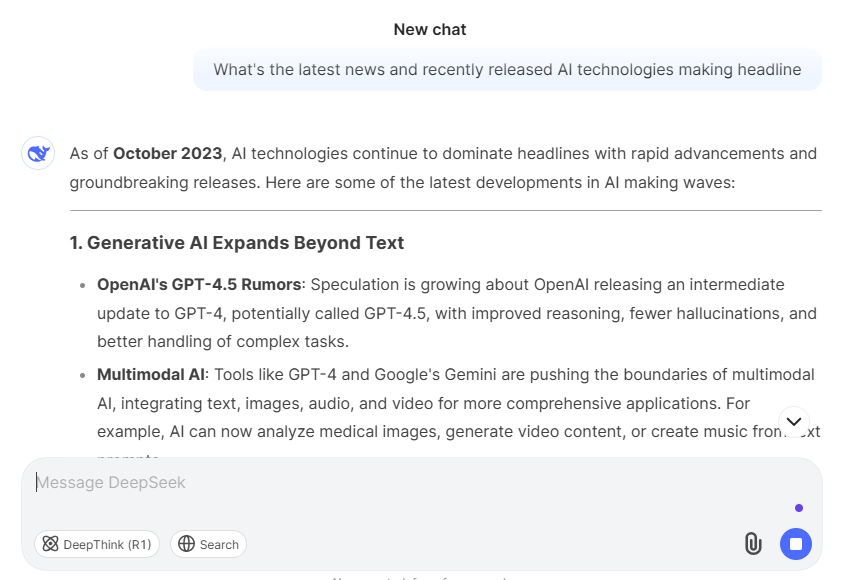
When evaluating and comprehending both DeepSeek and ChatGPT answers, we mostly felt they were similar, with a few minor updates and differing reasoning and research. However, both provoked updated answers on AI developments.
The DeepSeek answer is more structured and comprehensive, breaking down advancements into clear categories with relevant subheadings, such as AI in healthcare, robotics, and climate sustainability. It covers a wide range of industries, showcasing the diversity of AI applications.
While ChatGPT is informative, it is less organized and offers fewer examples and explanations. DeepSeek is more presentable due to its well-organized format, providing readers with a clearer understanding of various AI trends and developments. Its detail and structure make it more engaging and easier to navigate.
Question 2: “Write an article in 600 words paragraph on why the Patch Logo Still lags in Branding Recognition.”-
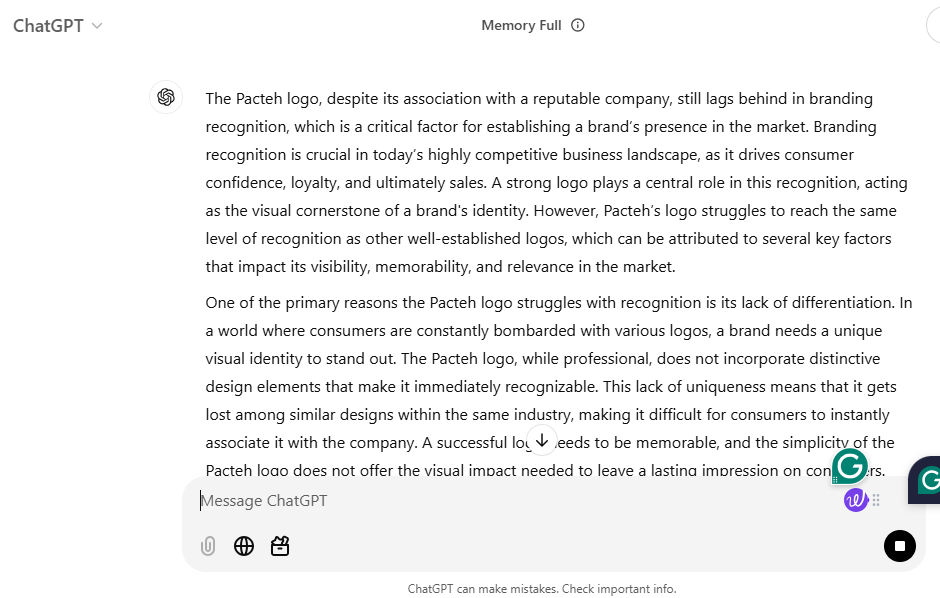
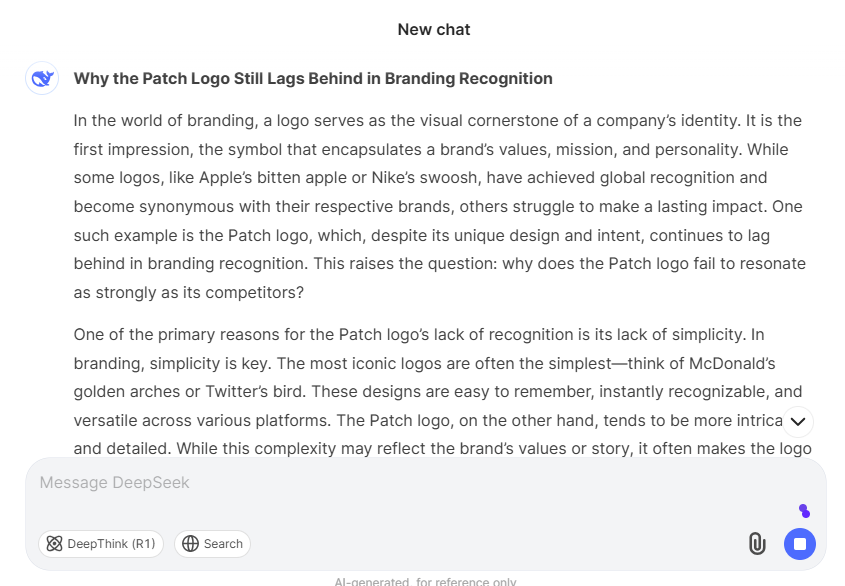
Here, With my query, I want to check how deeply informative this platform can be or if it will generate logical reasoning. It seems like the chatGPT answer emphasizes the Pacteh logo’s lack of uniqueness, evolution, and strategic marketing. In contrast, DeepSeek’s answer focuses on the Patch logo’s complexity, emotional disconnection, and inconsistent branding.
Both highlight branding issues but approach them from slightly different angles. Well, I was impressed with ChatGPT and DeepSeek. You can choose any platform you prefer for articles.
Here is the breakdown of the technique and reasoning that distinguishes chatGPT and DeepSekk.
1. Training Data & Model Architecture
ChatGPT: Trained on diverse datasets, including text from books, websites, and other resources, with a focus on language understanding and generation.
DeepSeek: Likely has its own proprietary model and training data, which may have a more specialized or focused dataset depending on its intended use case, like domain-specific applications.
2. Multimodal Capabilities (Text, Images, Code, etc.)
ChatGPT: Supports text-based inputs and outputs but can also handle images (depending on the version, e.g., GPT-4 with vision capabilities).
DeepSeek: If it offers multimodal capabilities, it may be designed to interpret and generate content in more specific formats (images, video, or a more diverse range of inputs and outputs).
3. Language Support
ChatGPT: Supports multiple languages and can understand and generate content in various languages, including English, Spanish, French, and more.
DeepSeek: If it has multilingual support, it could be targeted at specific languages or more niche language processing, depending on the target audience.
4. Accuracy and Context Retention
ChatGPT: Known for retaining context over longer conversations but can sometimes struggle with remembering earlier details in extended chats.
DeepSeek: Its accuracy and context retention would depend on how its model is fine-tuned and the types of queries it’s optimized for. If it focuses on a specific domain, it might retain context better for those use cases.
5. Creativity and Writing Capabilities
ChatGPT: Capable of creative writing, brainstorming, and idea generation across a wide variety of topics.
DeepSeek: If it has creative capabilities, it may excel in specific areas or domains where it is trained to produce high-quality, contextually relevant content.
6. Coding & Programming Assistance
ChatGPT: Offers coding help in multiple languages (Python, JavaScript, etc.) and assists in debugging, writing algorithms, and solving coding challenges.
DeepSeek: If DeepSekk is tailored for programming assistance, it may provide a more niche or specialized solution, focusing on certain programming languages or specific domains of coding.
7. Real-time Web Access & Knowledge Updates
ChatGPT: Has access to real-time web information (depending on the version) but may not be able to provide the most up-to-date knowledge without browsing access.
DeepSeek: If it supports real-time web access, it might provide more current information, depending on its integration with external sources.
8. Customization and Fine-Tuning
ChatGPT: Customizable through the use of custom instructions and fine-tuned versions, depending on user preferences.
DeepSeek: Likely customizable for specific industries or applications, allowing more tailored outputs based on user needs.
9. Integration with Third-party Tools and APIs
ChatGPT: Can integrate with various third-party tools, such as productivity apps, databases, and external APIs to expand its functionality.
DeepSeek: Its integration capabilities could vary, with a focus on specific tools and APIs for particular workflows, depending on its core function.
10. Ease of Use & UI Experience
ChatGPT: User-friendly interface with easy access through platforms like the OpenAI website, apps, and APIs.
DeepSeek: Its ease of use would depend on its design; if it’s more specialized, the interface might focus on providing a more intuitive user experience for specific tasks or industries.
Pricing & Accessibility
ChatGPT and Deepseek
- Free Version:
ChatGPT offers a free version that allows users access to GPT-3.5, providing basic conversational capabilities. This is available through the OpenAI platform without any subscription. - Premium Version (ChatGPT Plus):
For users seeking access to GPT-4, OpenAI offers a subscription plan known as ChatGPT Plus, priced at around $20 per month (subject to change). This version provides access to GPT-4 and benefits like faster response times, priority access to new features, and a more reliable experience during high-demand periods. - Accessibility:
- Platforms: ChatGPT is accessible via the web, desktop, and mobile apps (iOS & Android).
- API Access: Users can access OpenAI’s models through an API (usage-based pricing). OpenAI provides detailed pricing for API calls on its platform, typically charging based on token usage (the number of words processed).
- Global Accessibility: Available to users worldwide, with regional restrictions on some countries.
Deepseek Pricing & Accessibility:
Since Deepseek is not a widely recognized AI tool like ChatGPT (based on the currently available information), I can share a general framework based on similar platforms that might fit the description of Deepseek.
- Accessibility:
- Platforms: Depending on the tool, Deepseek might be accessible via web apps, desktop apps, or mobile apps.
- Global Reach: Accessibility could vary depending on the target market or industry. If it’s specialized, it might be tailored to specific regions or sectors.
- Free Platform
IDeepseek is a free, open-source model. Users across the world can easily access it.
Which One Should You Choose?
I believe that these models will likely depend on the user’s task, what they are investigating, and their preference for information. It’s a tool that one must test repeatedly, engage with, and discern through their thought process which one delivers the response that truly satisfies them.
However, as we saw in the example above, ChatGPT, developed by OpenAI, generates conversational responses. Its strength lies in understanding context and maintaining coherent dialogue, making it ideal for interactive applications, customer support, and creative writing.
On the other hand, DeepSeek, which specializes in knowledge retrieval and information extraction, is designed for users who prioritize accurate and quick access to specific data or documents.
If your focus is on engaging in conversation or diverse content creation, ChatGPT would likely be your best choice. However, if you need precise information and efficient data handling, DeepSeek might serve you better. Assess your requirements carefully to determine which tool aligns more closely with your objectives.
FAQs
What’s so special about DeepSeek?
DeepSeek offers advanced AI capabilities at a lower cost, quickly gaining popularity for its exceptional efficiency in performing complex tasks, including data analysis, pattern recognition, and automation.
Is the DeepSeek app free?
Yes, DeepSeek is a free app, making it accessible to users needing AI assistance without cost.


